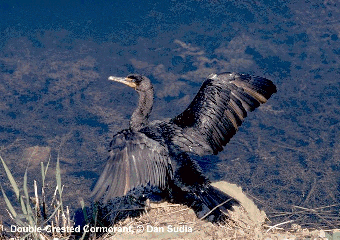
Double-crested Cormorant--A large, dark waterbird with a long, hooked bill
and long tail. It often perches with wings spread to dry them. Cormorant feathers can
become more waterlogged than those of many other diving birds. By compressing the air from
the feather, bouyancy is lost and so diving is easier. However, the birds then have more
trouble drying out when they leave the water and so have to sit with outsretched wings for
some time.
Image © by permission of Dr. Daniel Sudia for educational purposes.
|
| 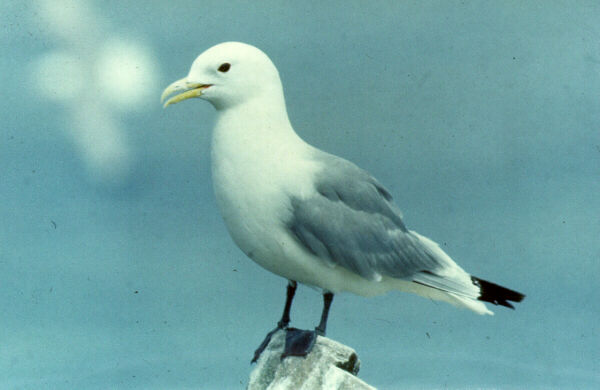
The Black-legged Kittiwake (Rissa tridactyla) nest on very narrow
ledges, the nest often overlapping the edge. The birds have a number of displays which
prevent undue fighting on such limited areas.
|
| 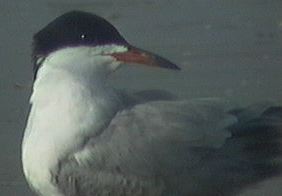
Common tern (Sterna hirundo)
|
| 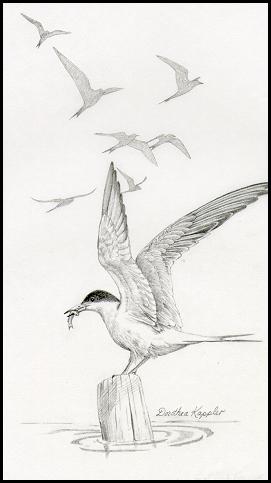
Common tern
Any small seabird with a forked tail found over the water and calling stridently is
usually a tern, and common terns are the most widely distributed of this group in Canada.
When feeding, terns hover with rapid wing beats. As soon as they spot a school of fish
near the surface, they make a swift, shallow dive, snatching their prey in passing and
emerging from the water to swallow it.
|
| 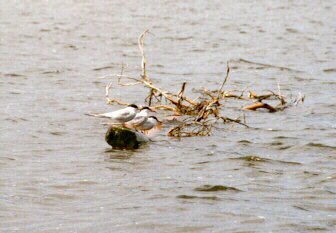
Common tern
|
| 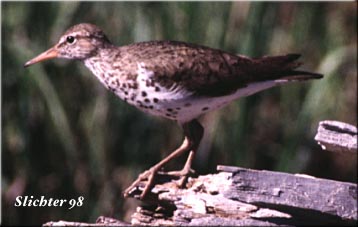
Spotted Sandpiper
Sandpipers feed mainly by probing in soft earth or sand for a variety of invertebrates --
earthworms, seaworms, molluscs, sandhoppers and many other small crustaceans, insects
grubs and so on. While highly gregarious during the rest of the year, sandpipers breed as
solitary pairs which are aggresively territorial. Many species have elaborate courtship
flights and displays on the ground, accompanied ny melodious calls.
Copyright © 1998 by Paul Slichter
|
| 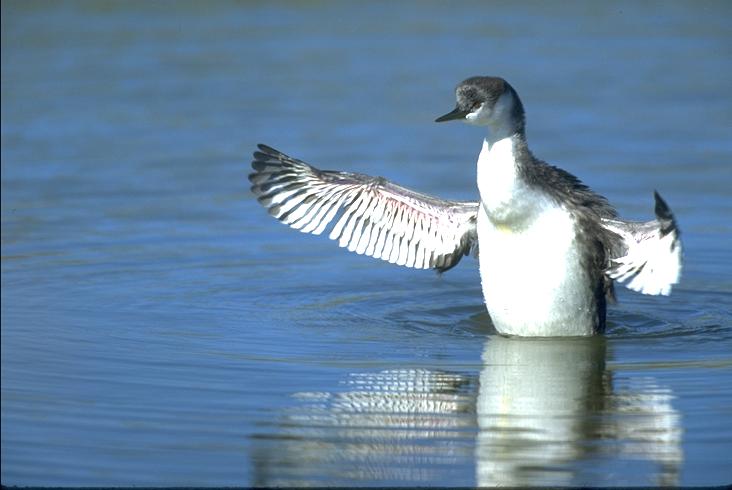
Western grebe
The grebes are highly specialized aquatic birds closely related to one another but to no
other known birds, living or fossil. For this reason, the family is included in its own
order, the Podicipediformes. Grebes are adapted for diving from the surface and for
underwater swimming. Their strong legs are situated at the rear of a rotund or somewhat
elongated, virtually tailless body. The large feet are partly webbed with well-developed,
paddle-like lobes on each of the three main toes, and are used to propel the bird at speed
under the water with a powerful, figure-of-eight movement. Most grebes can fly well, but
do so rather infrequently once settled down on a particular water. Their wings are
relatively small, necessitating a fast rate of flapping, and when not in use are usually
folded right away under the body plumage.
Copyright © 1999 Don Baccus
|
| 

Brown Pelicans
Brown pelicans are amongst the largest of all flying birds, and have an overall length of
between 50-72 inches (127-183 cm); weigh 10-25 pounds (4.5-11kg), with the larger species
having wingspans of up to 9 feet (2.7m). The legs are short and stout with large feet
which, like those of the majority of the families within the Pelicaniformes, are fully
webbed. The most obvious character by which one can identify pelicans is that of the bill.
This is very long, straight, flattened, hooked at the tip, with a large elastic pouch
suspended beneath the lower mandible. The diet of the pelican is mainly fish, but
crustaceans are sometimes eaten. The basic adaptation of the group for fishing is the
bill, and contrary to general belief the pouch is not used for storage or holding fish,
but simply as a catching apparatus that acts as a scoop net. The pouch, however, is not
permeable like a net, but is highly expansive and elastic. When the bird plunges its bill
into the water the flexible lower mandible expands automatically into a broad oval scoop.
As the pelican raises its head from the water the fish are trapped in the pouch. The pouch
then contracts to its original shape and the upper mandible closes like a lid over the
lower jaw, thus preventing the fish's escape. The prey is then swallowed whole, but can be
transported long distances in the bird's gullet in a partially digested state.
|
| 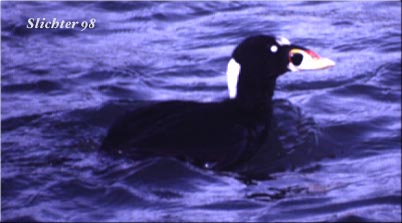
Male Surf Scoter (Melanitta perspicillata)
Scoters are sea ducks that raft on the water and dive for food such as mullusks and
crustaceans.
|
| 
Herring Gull
When searching for food, Herring Gulls fly around the countryside in loose groups,
gathering to soar where there are updraughts along the hill-crests or on the windward side
of a ship, and following promising sources of food such as a tractor pulling a plough or a
trawler hauling its nets. Their long wings are adapted for easy, graceful flight and for
soaring updraughts. They have moderately long legs and webbed feet and can swim easily on
the surface of the water. They will plunge for food but do not dive deeply.
Photo copyright © 1996 by Paul Slichter
|
| 
Common egret
Some egrets were brought to the verge of extinction by the plume trade early in the 20th
century.
Photo copyright © 1999 by Don Baccus
|
| 
Belted Kingfisher
Kingfishers commonly breed in dry sandbanks along rivers. They usually breed in the summer
or dry season when the banks are not liable to flooding; at the time when the rivers are
low the small fish can be more easily seen and caught.
Photo copyright © 1999 by Don Baccus
|
| 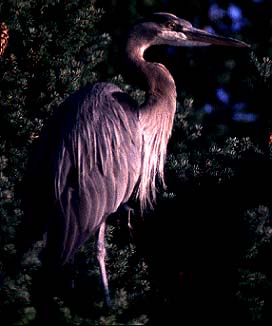
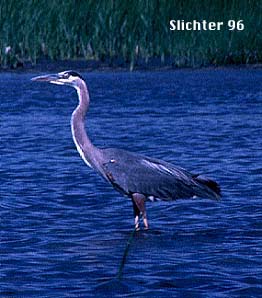
Great Blue Herons
Adapted for wading, herons feed mainly on fishes and other animal life caught near water.
Photos copyright © 1996 Paul Slichter
|
| 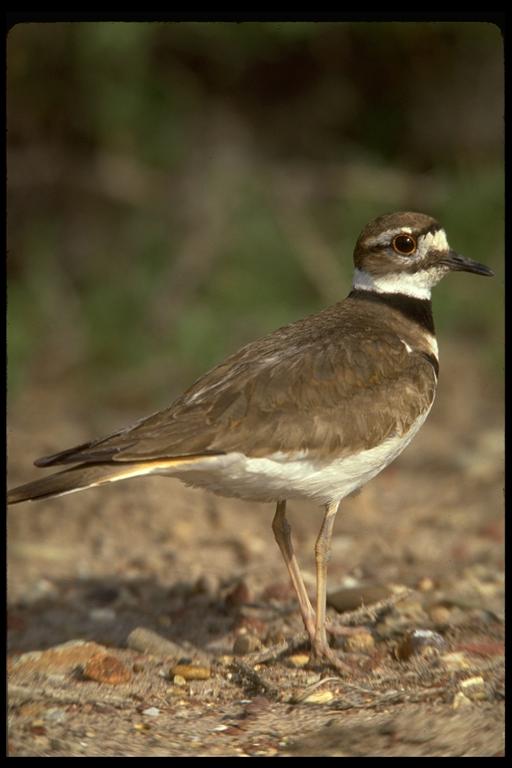
Killdeer
Photo copyright © 1999 by Don Baccus
|
| 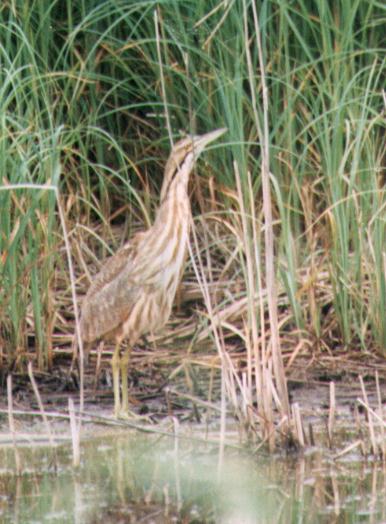
American Bittern
Bitterns are relatives of the herons; usually they are well camouflaged and live
secretively in reed beds. When danger threatens, bitterns stretch themselves upright and
stand very still hoping that they will blend with the surrounding reeds. If discovered
they may flap their wings and make themselves appear as large as possible in the hope of
frightening the enemy away.
Photo Copyright © 1995 by Dave Cahlander
|
| 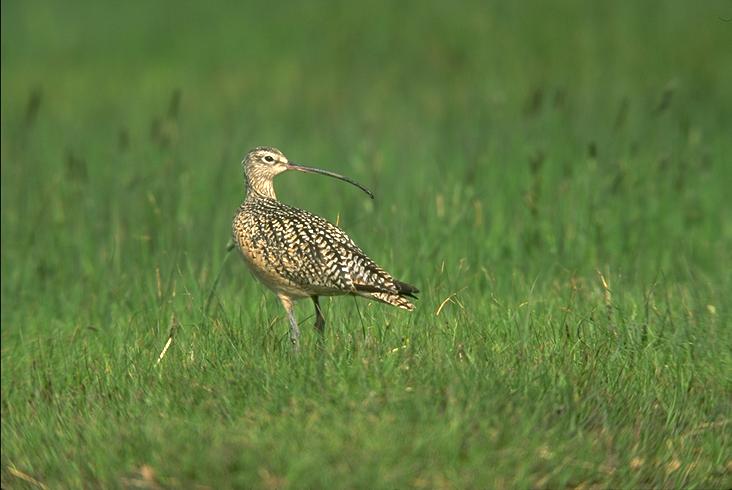
Long-billed Curlew
Photo copyright © 1999 by Don Baccus
|
